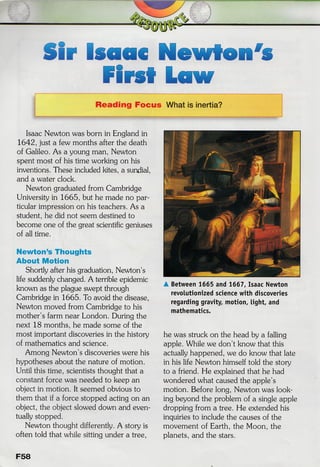
Sir isaac newton's first law
- 1. Sir lseieic Newton's First leiw Reading Focus What is inertia? Isaac Newton was born in England in 1642,just a few months after the death of Galileo. As a young man, Newton spent most of his time working on his inventions. These included kites, a sundial, and a water clock. Newton graduated from Cambridge University in 1665, but he made no par- ticular impression on his teachers. As a student, he did not seem destined to become one of the great scientific geniuses of all time. Newton's Thoughts About Motion Shortly after his graduation, Newton's life suddenly changed. A terrible epidemic known as the plague swept through Cambridge in 1665. To avoid the disease, Newton moved from Cambridge to his mother's farm near London. During the next 18 months, he made some of the most important discoveries in the history of mathematics and science. Among Newton's discoveries were his hypotheses about the nature of motion. Until this time, scientists thought that a constant force was needed to keep an object in motion. It seemed obvious to them that if a force stopped acting on an object, the object slowed down and even- tually stopped. Newton thought differently. A story is often told that while sitting under atree, F58 A Between 1665 and 1667, Isaac Newton revolutionized science with discoveries regarding gravity, motion, light, and mathematics. he was struck on the head by a falling apple. While we don't know that this actually happened, we do know that late in his life Newton himself told the story to a friend. He explained that he had wondered what caused the apple's motion. Before long, Newton was look- ing beyond the problem of a single apple dropping from a tree. He extended his inquiries to include the causes of the movement of Earth, the Moon, the planets, and the stars.
- 2. The Concept of lnertia Over time, Newton worked out a num- ber of hypotheses explaining the nature of motion. The basis of all these hypoth- eses is now known as Newton's first law of motion. According to this law, objects at rest tend to remain at rest. Objects in motion tend to stay in motion, traveling at a constant speed and in the same direction. The tendency of an object to -*-' remain at rest or to remain in motion is called inertia. We expect a rock to remain sitting at the top of a hill. Similarly, a ball rolling across a table top might be expected to continue rolling in the same direction; no force is needed to keep it in motion. What we do have to explain are changes in the conditions that influence an object's motion. For example, sup- pose that the rock starts rolling down the hill. The problem is to explain why the rock changed its state. What change in conditions made the rock start rolling down the hill? Or suppose that a rolling ball speeds up, slows down, or changes direction. You'll discover Newton's explanation for those changes in the ball's condition in the next investigation. Examples of lnertia You can find many examples of inertia in everyday life. In the activity on pages F56 and F57, for example, inertia causes the crash dummy to change position when the truck stops suddenly. Similarly, suppose you are standing in the aisle of a bus that is traveling at a constant speed of 40 km/h (25 mph). What would happen if the driver suddenly slammed on the brakes? Chances are you'd fall forward as the bus came to a stop. This would happen because your body has A Unless acted on by some force, this rock will forever balance on top of the other rock. What measurable forces could affect the balance of the rock? inertia while the bus is traveling forward. Your body is moving in the same direction and at the same speed as the bus. When the driver hits the brakes, the bus comes to a stop, but inertia keeps your body moving forward. A similar explanation applies to sudden starts by the bus. You stand quietly in the aisle while the bus driver waits for the last passenger to board. At some point, the driver suddenly steps on the accelerator. The bus lurches forward. What happens to you and the other passengers? How does inertia explain the changes that occur? I F59
